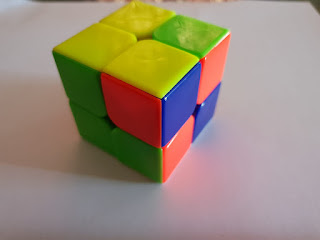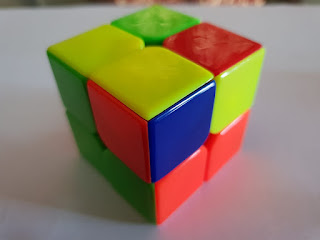Basic Ideas to solve 2x2 rubik's cube
I want to write down basic ideas around solving this basic 2x2 rubik's cube for my future reference or anyone else wanting to learn about it.
First some notations to denote the type of twist so that we have a vocabulary to talk about them. Imagine one side of cube facing you, then you can rotate it by clockwise or anti clockwise. Smallest meaningful twist being a 90 degree single twist.
Now lets denote the six faces, imagine a cube facing you :
F - front side facing you
B - back side
L - side on your left
R - side on your right
T - top side
D - down side
Now when F is written , it means a single smallest clockwise turn of face F
F' (read as F dash or F prime), here prime denotes anti clockwise turn
Now we can build a sequence of turns , say FFF' - which means two turns clockwise of F then one anti clockwise of F
Now let's get to the interesting part.
The key to solving this or any other cube is being able to find a sequence of operations which result in exchange of positions only within a layer. This is helpful to change one layer while restoring the other layer.
Let me elaborate, say you have two layers as in 2x2 cube, now if you carry out a sequence of changes say say FBDT (front, back, down, top) and then reverse each step by a reverse sequence - T'D'B'F', in the end you will be in same cube configuration with which you began. Now same logic but with layers, say you carry out sequence S1 - which results in change in layer 1 and layer 2 , but nothing was exchanged in layer 1 and layer 2, compared to the initial state.Now if we do rotate only layer 1 and carry out the REVERSE of S1, then layer 2 will be restored to original but layer 1 will have two new changes - one due to S1 in initial orientation of layer 1 and other due to reverse of S1 in a different orientation of layer 1.
Enough theory, now some practical. Lets try to twist an edge of layer 1 by sequence :
R'D'RDR'D'R
This is what we get :
What this does is that it changes only one cubelet (small cube) in top layer and all other cubelets in top layer remain at their place. Everything in bottom layers goes here and there like crazy but we don't care and can fix bottom layer by running the reverse sequence ( R'DRD'R'DR ) . But before we do that lets do a top twist -( T ). Now in this case the cubelet previously changed in layer 1 will remain unchanged but another cubelet will change in reverse. Now ending with a T' - anticlockwise top twist, we get :
You can clearly see that the first cubelet has a clockwise twist (if u imagine) and the next cubelet has an anti clockwise twist, also rest of cube remains unchanged. Now you understand how to change two cubes in a layer without disturbing the rest of cube. This is useful to orient the cubelet correctly when it is at right position (its final resting place when solved) but twisted wrongly.
Another very useful technique is to learn how to swap two adjacent cubelets in a layer. We start again from the solved cube. Once we do this sequence : RFD'F' , two adjacent cubes in top layer are swapped and bottom layer is also messed up. See :
Now if you twist the top layer by one (T) and reverse the sequence ( FDF'R' ) and then twist back top layer by one in opposite direction (T') , you will see that the bottom layer is restored and other two cubelets swapped their position - if you observe the cubelet with Yellow-Green-Orange face moved twice and is not diagonally opposite compared to its solved state. See :
This can be used to swap three positions and put the cubelets into correct position.
Now one interesting question is how does one come up with sequences like : RFD'F' or R'D'RDR'D'R , these come from practice as you get to "understand" cube and try to make moves such that each layer is changes separately.
For example for RFD'F' : try swapping by moving one cubelet into another's position, then using another layer try getting other cube into its final place. Generally keeping track of steps taken on paper helps to keep track of what you doing when coming up with new sequences like RFD'F' etc
Finally I try to solve the cube starting from the above state using adjacent swipe in following video:





Comments
Post a Comment